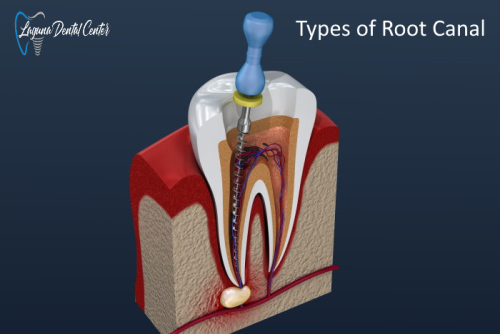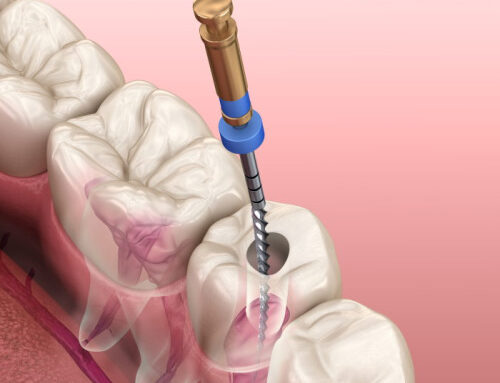Table of Contents
 A root canal treatment is a way to salvage a tooth that has been seriously decayed or injured. The most typical root canal procedure doesn’t require surgery. Before a tooth needs to be extracted, a dentist will conduct a root canal as a last resort. When germs in the pulp of your tooth create pain or swelling, root canal therapy is recommended. Your dental health and risk of severe health problems will suffer if you wait longer than necessary for a root canal treatment. During a root canal, the dentist will remove the infection from inside your tooth. Following the removal of the infection, the dentist cleans the root and inserts a filling to close the opening. Brush your teeth and maintain good dental hygiene to avoid infection before a root canal procedure is required. In the following weeks, the temporary filling will be removed, and a permanent crown will be placed.
A root canal treatment is a way to salvage a tooth that has been seriously decayed or injured. The most typical root canal procedure doesn’t require surgery. Before a tooth needs to be extracted, a dentist will conduct a root canal as a last resort. When germs in the pulp of your tooth create pain or swelling, root canal therapy is recommended. Your dental health and risk of severe health problems will suffer if you wait longer than necessary for a root canal treatment. During a root canal, the dentist will remove the infection from inside your tooth. Following the removal of the infection, the dentist cleans the root and inserts a filling to close the opening. Brush your teeth and maintain good dental hygiene to avoid infection before a root canal procedure is required. In the following weeks, the temporary filling will be removed, and a permanent crown will be placed.
What are the types of root canal?
Non-surgical root canal therapy, apicoectomy, pulpotomy, and pulpectomy are the many types of root canal procedures. The most frequent root canal technique is non-surgical root canal therapy. The dentist drills more deeply to clean the canal than during a typical filling. The tooth’s root tip and surrounding tissue are removed in an apicoectomy, sometimes referred to as endodontic microsurgery. The tooth’s pulp is partially removed during a pulpotomy, although the tooth’s roots might remain in place. During a pulpectomy, the pulp is removed from the whole tooth, including the roots.
Non-surgical Root Canal Procedure
The most frequent type performed to preserve your natural tooth is a non-surgical root canal. A non-surgical root canal is akin to getting a reasonably deep filling done because it is not unpleasant. To gain access to the root canal and clean it, the dentist drills down further than they would during a typical filling.
Apicoectomy Surgery
Because it treats the end of the tooth’s root tip, an apicoectomy is sometimes referred to as a root-end resection. Endodontic microsurgery is another name for an apicoectomy. When a typical root canal is unsuccessful, an apicoectomy is required. The dentist exposes the gum tissue next to the tooth so that the gum or any infection is visible. An apicoectomy is a procedure that necessitates the removal of a tooth’s root tip and surrounding tissue. A tiny portion of the root tip is also eliminated along with the damaged tissue. The region will be filled with a root-end filling to stop the root from being reinfected.
Pulpotomy and Pulpectomy
Both a pulpotomy and a pulpectomy include the removal of the infected pulp tissue. A pulpotomy is a technique that allows the tooth’s roots to remain in place while a portion of the tooth’s pulp is removed. A pediatric root canal operation is called a pulpotomy. Mineral trioxide aggregate, ferric sulfate, and calcium hydroxide are the most often utilized materials in pulpotomy. A pulpotomy is required if the decay or damage is limited to the tooth’s crown. Children are frequently treated with a pulpectomy as well. The whole crown and root of the infected pulp tissue are removed during a pulpectomy. A pulpectomy should be performed if the tissue in both the dental crown and the tooth root is infected.
Root Canal Retreatment Procedure
The prior treatment’s material must be removed during a root canal retreatment. The dentist will remove any infection from the tooth before adding fresh filling material and performing retreatment to avoid infection. You will require a root canal retreatment if you have recently developed dental decay or tooth damage. It is possible to have a root canal retreatment two or more times. Retreatment of a root canal takes 90 minutes.
Waterlase System Laser Dentistry
With the WaterLase dental laser, your dentist may treat you without using a drill or scalpel. The painless WaterLase technology emits a laser beam that is powered by water. The WaterLase system mixes water, air, and laser radiation to lessen microorganisms and eliminate deterioration. If you prefer a more accurate and pleasant technique, choose Waterlase.
Purpose of Different Types of Root Canal Procedures
Several Endodontic treatment may be chosen based on your comfort level and dental health. Infected tissue, debris, and germs are removed during the GentleWave root canal operation using fluids and soundwaves. The BIOLASE Waterlase system employs light, water, and air to clear away germs from the root canals, making it less intrusive than the standard type of therapy. Endodontic microsurgery is required if the treatment applied to the infected tooth’s root apices is ineffective. Retreating a root canal entails removing the old filling material, cleaning the region, and replacing it with fresh materials.
What is the Difference Between a Non-surgical Root Canal Treatment and an Apicoectomy?
In a non-surgical root canal, the dentist drills more deeply than during a filling to gain access to the root canal and allow for cleaning. The dental professional performs an apicoectomy by removing the tooth’s root tip and filling the root end cavity.
Is an Apicoectomy More Painful Than a Traditional Root Canal?
Yes, an apicoectomy is more painful since it is more intrusive than a regular root canal.
Dr. Ronald Ayzin at Laguna Dental Center is a dentist who specializes in root canal treatment. Dr. Ronald Ayzin looks forward to restoring the health of your teeth.


